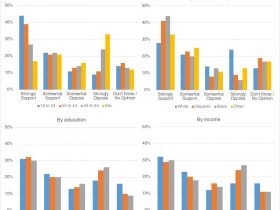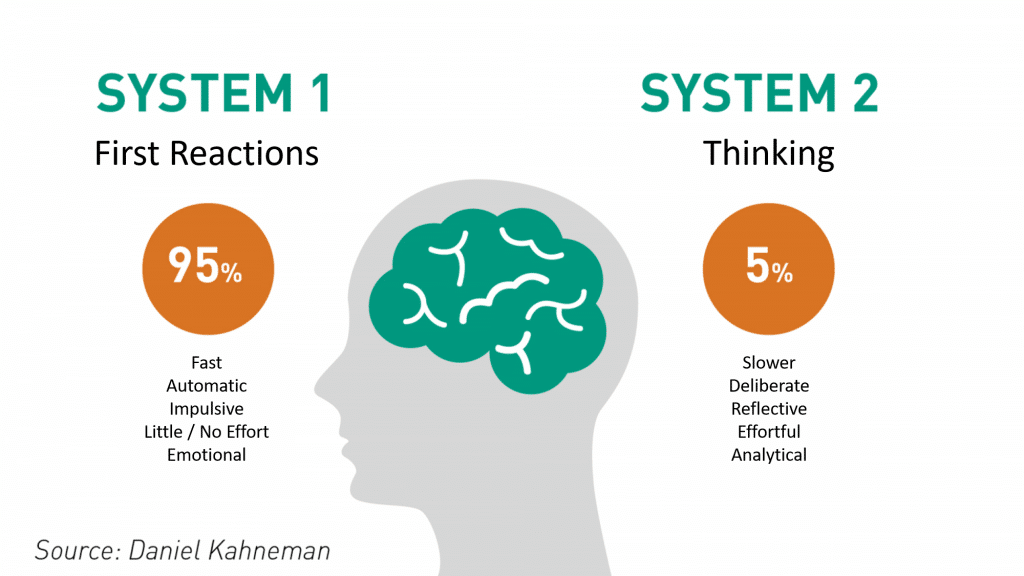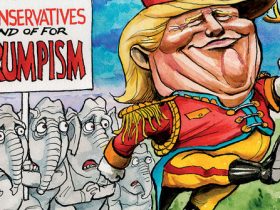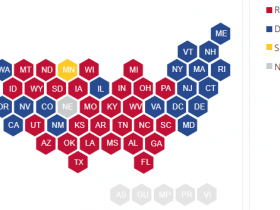Today I’m sharing an extremely well-done video by Vox about asymmetric polarization and Norm Ornstein’s case for why Republicans have broken politics. Asymmetric polarization is defined as one political side has become more extreme than the other.
Norm Ornstein is an American political scientist, a popular author, and a resident scholar at the American Enterprise Institute, a Washington D.C. conservative think tank.
Norm points to Republicans leading the charge of polarization with filibusters as well as a metric that I don’t fully understand about how conservative ideologies have shifted further right.
This is all to say that I find this concept fascinating and it passes the eye test for me but it’s not easy to measure with data.
If you want to understand the strongest arguments against asymmetric polarization, check out this Quora post and the Amazon review I’ve pasted below the video. To learn more about this concept, check out Norm Ornstein’s book.
The Case Against Asymmetric Polarization (from this Amazon comment)
If Basic Books had inadvertently listed the authors of It’s Even Worse Than It Looks as being James Carville and Paul Begala instead of Thomas Mann and Norman Ornstein, no one would have suspected that this book was written by “scholars.” That is because this book is not a scholarly work written by academics, but a political hit piece written by two left-wing partisans.
Mann and Ornstein (hereafter referred to “Mannstein” for brevity) give away the game in the first chapter. According to Mannstein seven Republican cosponsors of a Senate resolution later voted against the resolution “solely because President Barack Obama, a Democrat, had endorsed it.” Their evidence to support this claim? The opinion of liberal columnist with a liberal newspaper. None of the cosponsors is on record stating that he or she voted against the resolution because Obama endorsed it, and Mannstein completely ignored the reasons the cosponsors cited for voting against the resolution. Mannstein also made a factual error with their claim. Only six cosponsors voted against the resolution. The seventh, Lisa Murkowski of Alaska, had co-sponsored the bill and planned to support it but was forced to miss the vote for family reasons.
Mannstein also fail to mention that 22 Democrats and socialist Bernie Sanders also voted against the resolution.
Mannstein blame the current polarization of the parties on the GOP, and write that “the seminal moment of this campaign of agitation” began in 1984 with Newt Gingrich. Gingrich further radicalized the GOP by running against Congress in 1994. According to Mannstein, the situation got worse after the GOP won control of the House and Senate that year. Mannstein pointed to Gingrich’s “extreme” rhetoric.
When pointing to Gingrich and the GOP, Mannstein demonstrate their proclivity to cherry pick anecdotes to make their points. While they briefly mentioned the “brutal attacks on Robert Bork in 1987,” they fail to share any of those attacks. Let’s consider what Ted Kennedy said: “Robert Bork’s America is a land in which women would be forced into back-alley abortions, blacks would sit at segregated lunch counters, rogue police could break down citizens’ doors in midnight raids, schoolchildren could not be taught about evolution, writers and artists could be censored at the whim of the Government, and the doors of the Federal courts would be shut on the fingers of millions of citizens for whom the judiciary is–and is often the only–protector of the individual rights that are the heart of our democracy … President Reagan is still our president. But he should not be able to reach out from the muck of Irangate, reach into the muck of Watergate and impose his reactionary vision of the Constitution on the Supreme Court and the next generation of Americans. No justice would be better than this injustice.”
Mannstein cannot point to anything Gingrich has said that is as irresponsible, dishonest, and extreme, yet they claim that Gingrich is “the singular political figure who set the tone that followed.” Mannstein completely ignore the “high-tech lynching” of Clarence Thomas several years later. They claim that there has been “an endless cycle of confrontation over judicial nominees” since the Bork hearings, but it that really true? Thomas was confirmed by a vote of 52-48. However, Ruth Bader Ginsburg, a Clinton nominee, was confirmed by a vote of 96-3. Stephen Breyer, also a Clinton nominee, was confirmed by a vote of 87-9. How did the Democrats respond when Bush 43 offered his two nominees. John Roberts was confirmed by a vote of 78-22. Samuel Alito was confirmed by a vote of 58-42. Obama voted against both Roberts and Alito. He was even part of a failed filibuster attempt regarding Alito. Nevertheless, Mannstein argue that the GOP is responsible for the “endless cycle of confrontation over judicial nominees.” They also complain about the GOP opposing Obama’s nominees when Obama rejected both of Bush 43’s Supreme Court nominees.
Mannstein claim that there has been an “asymmetric polarization” in Congress, and that the GOP is, as a party, an “ideological outlier.” Their evidence to support this claim? “More than 70 percent of Republicans in the electorate identify themselves as conservative or very conservative, while only 40 percent of rank-and-file Democrats call themselves liberal or very liberal.” Mannstein did not note what percentage of Democrats identify themselves as “progressive,” as Hillary Clinton did during the 2008 primaries.
Note that a Harris poll in July 1963 found that 34 percent of Americans classified themselves as conservatives, while 24 percent classified themselves as liberals. The percentages today are roughly 40 percent and 20 percent, respectively, which isn’t really a huge shift during the past fifty years.
Now, if just 40 percent of Democrats truly identify themselves as “liberal or very liberal,” we have to ask why they elect so many liberals to represent them in Washington. Every year, Americans for Democratic Action, the oldest and largest liberal lobbying organizations, ranks all members of the U.S. House and Senate on a scale from 0-100, with 0 being the most conservative and 100 being the most liberal. Those with “liberal quotients” (LQs) between 40 and 60 can be considered “moderates.” In 2012, only a handful of House Democrats were ranked in that range. Not a single Senate Democrat was ranked in the “moderate” range. The only “moderates” were Republicans Snowe and Collins of Maine and Brown of Massachusetts (you can be sure that Brown’s replacement, Elizabeth Warren, a socialist, will have an LQ in the 85-100 range for 2013).
A recent Rasmussen poll found that 50 percent of Americans believe that the GOP’s agenda in Congress in “extreme.” That may seem to confirm Mannstein’s portrayal of the GOP as an ideological outlier. However, the same poll found that 46 percent say the same of the Democrats’ agenda. In addition, 56 percent believe the average Democrat congressman is more liberal than them, while 54 percent believe Obama is more liberal than them. Fifty percent see the average GOP congressman as more conservative than them.
Oddly, in a book about the “new politics of extremism,” Mannstein make no mention at all about the Congressional Progressive Caucus and the Democratic Socialists of America. There are nearly 80 members of the Congressional Progressive Caucus (CPC), which is made up of House Democrats (Bernie Sanders, an independent who calls himself a “democratic socialist”, helped start the caucus when he was a House member).
According to the March-April 1997 issue of New Ground, the Chicago Democratic Socialist of America’s newsletter, “Political Director Chris Riddiough provided a synopsis of her paper on DSA’s mission which stated ‘DSA’s purpose is to establish socialism as a political force in the U.S. and around the world by training mobilizing socialist activists, building progressive coalitions and education [sic] people and public officials about democratic socialism.'” Further, “DSA goals by 2017 include: a U.S. President from the Progressive Caucus, a 50 member socialist caucus in Congress, successful programs of the likes of universal health care, progressive taxation, social provision and campaign finance reform.”
The DSA identified the CPC as a “socialist caucus in Congress.” In fact, the DSA originally hosted the CPC’s webpage. It was later moved to Sanders’ House website after the late Balint Vazsonyi exposed the DSA-CPC alliance.
On DSA’s website, you can also find a 2009 PDF file entitled “What is Democratic Socialism?” Oddly, while CPC and DSA deny that they work together, we find the following question and answer on the third page:
“Q: Aren’t you a party that’s in competition with the Democratic Party for votes and support?
“A: No, we are not a separate party. Like our friends and allies in the feminist, labor, civil rights, religious, and community organizing movements, many of us have been active in the Democratic Party. We work with those movements to strengthen the party’s left wing, represented by the Congressional Progressive Caucus.
“The process and structure of American elections seriously hurts third party efforts. Winner-take-all elections instead of proportional representation, rigorous party qualification requirements that vary from state to state, a presidential instead of a parliamentary system, and the two-party monopoly on political power have doomed third party efforts. We hope that at some point in the future, in coalition with our allies, an alternative national party will be viable. For now, we will continue to support progressives who have a real chance at winning elections, which usually means left-wing Democrats.”
The DSA is a member of the Socialist Intenrational, which, according to Michael Harrington, who led the DSA until his death in 1989, claims “direct descent from Marx’s International Workingmen’s Association.”
It would seem that any objective analysis of extremism in Congress would have to deal with CPC and DSA, which both have the explicit goal of polarization within Congress and the electorate at large. Yet Mannstein are either ignorant of the socialist caucus in Congress or deliberately choose to ignore it when attempting to make their case against the GOP. Obviously, a party with a large number of Marxists combined with another party dominated by Lockeans is not a recipe for compromise. Marx wrote that the goal of the socialists is the abolition of private property, while Locke wrote that the chief aim of government is the preservation of private property.
Mannstein also engage in cherry picking when they criticize Romney’s super PAC, but make no mention of Obama’s Organizing for America. They mention the Koch brothers, which everyone on the far left feels obligated to do, but make no mention of George Soros, who spent $25 million to defeat Bush 43 in 2004. They mention Gingrich (i.e., Newt, Inc.) making money after leaving office, but ignore the millions that Al Gore has made after serving as vice president. They do mention the selling of the Lincoln Bedroom to raise campaign funds, but fail to note that it was a Democrat, Bill Clinton, who did that. They claim that Republicans have tried to deny the legitimacy of Obama’s presidency, but ignore that Democrats claimed that Bush 43 was “selected, not elected.” They claim that the GOP is dominated by “birthers,” or those who believe Obama was not born in this country. However, they ignore that a Zogby poll found that more than 40 percent of Democrats were “truthers” doing the Bush 43 administration. The truthers believed that Bush either played a role in 9/11 or that he knew it was going to happen, but did nothing. Truthers such as Van Jones later joined the Obama administration. Mannstein criticize Senate Minority Leader Mitch McConnell’s statement regarding making Obama a one-term president, as if the opposition party in the past did not have the same goal. Have they forgotten Rep. Richard Gephart’s slogan about Bush 43: “Like father, like son, one term and he’s done”? Mannstein note that a large number of Democrats went along with Bush’s tax cuts and the war with Iraq, but few, if any, Republicans went along with Obama on Obamacare and Dodd-Frank. They do not mention that a majority of Americans initially supported the tax cuts and the war with Iraq. Obamacare has never enjoyed majority support. After Dodd-Frank passed, CNN reported that “Everyone hates Dodd-Frank.” “Just 12% of the thousand-odd respondents to the survey describe themselves as satisfied with the legislation, which was signed into law in July in reaction to the meltdown two years ago of the financial system. That compares with 54% who say they are dissatisfied.” Mannstein greatly criticize Fox News for ideological programming, yet largely give MSNBC a pass, even though a Pew Research Center study that found MSNBC to be by far the most opinionated cable news channel in America. According to Pew, “opinion fills a full 85% of the channel’s airtime.
Mannstein claim that the language used by the GOP is not conducive debate and deliberation, “but is now guaranteed to bring spots on the best-seller lists and huge lecture fees.” Hypocritically, the Mannstein call Republicans “miscreants,” “gadflies,” “fire-breathers,” and other names. In addition, the first chapter is called “The New Politics of Hostage Taking.” It should be no surprise that Mannstein portrays the GOP as hostage takers, a line that has been picked out by liberals during the current government shutdown. Of course, hostage takers are terrorists and/or criminals, while the GOP is using legitimate and constitutional means to express their opposition. To portray them as hostage takers is to engage in the same behavior that Mannstein decries.
Mannstein attempts a little balance by throwing in an occasional Democrat for criticism. They lump in Democrat Alan Grayson with Republicans Joe Wilson and Michele Bachmann, whose “outrageous comments result in celebrity status.” Mannstein could have included Democrat Jesse Jackson, Jr., who invited a Republican “outside” to continue their debate. They also could have included Democrat Pete Stark, who made incendiary comments during his entire career. However, doing so would not fit in with Mannstein’s goal to put most of the blame on Republicans. Mannstein did the same with “bombastic and blustering figures in the political culture.” They mention two consoervatives, Ann Coulter and Erick Erickson, but just one liberal, Michael Moore. Of course, they could have also mentioned liberals Bill Maher or Al Franken. Remarkably, Mannstein thanked Franken for reading their manuscript.
Mannstein also makes numerous factual errors, such as writing that Sen. Nancy Kassebaum was from Ohio. Kassebaum represented Kansas, the same state that her father, Alf Landon, served as governor. They write that Sen. Ben Nelson is a “conservative Democrat,” yet ADA gave him a rating of 80 in 2012, which is well into liberal territory. Mannstein portray Obama as a “centrist,” yet, when Obama was a U.S. senator, National Journal found him to be the most liberal member of the Senate. Keep in mind that that Senate included Bernie Sanders, who identifies himself as a socialist.
Mannstein concludes their hit piece on the GOP with a few recommendations. They criticized term limits, yet note that Sen. Robert Byrd, a former KKK Kleagle (recruiter), had to be wheeled in from the hospital to cast a vote.
In an era in which polls find that large percentages of Americans believe the federal government is too large and intrusive, Mannstein calls for an even larger federal government and additional intrusiveness by requiring all eligible voters to vote. Those who fail to vote would be fined. As segments on “The Tonight Show” and elsewhere show, we already have a large number of low-information voters in this country. So exactly how would having even more ill-informed voters improve the situation?
A large percentage of Americans also believe that the media has a liberal bias. Research confirms this belief. Tim Groceclose’s research, which can be found in the book “Left Turn,” found that if not for liberal biases in the media, the United States in general would vote much like my state of Kansas. Kansas currently sends no Democrats to D.C., all statewide elected officials are Republicans, more than 80 out of 125 state representatives are Republicans, and the Democrats in the Kansas Senate can literally meet in a phone booth. Nevertheless, Mannstein argues for even more liberal bias.
Mannstein also advises the voters to punish the GOP by voting against it. This, according to Mannstein, is “a surefire way to bring the party back into the political mainstream.” This is a very strange argument. First, the Washington Post reported last week that “Americans are more conservative than they have been in decades.” When more than 40 percent of Americans consider themselves to be conservatives, while half that percentage consider themselves to be liberals, obviously the GOP is closer to the political mainstream than the Democrats. Second, we have about 80 members of the House Democrat caucus who belong to the socialist caucus. That’s nearly half of the Democrats in the House and they wield a great deal of power. If Mannstein truly believes the Democrats are in the political mainstream, why do these Democrats call themselves “progressives” rather than the more accurate “socialists”? Obviously, it’s because the label “socialist” is rejected by those in the political mainstream. And, obviously, an honest book concerning political extremism, ideological outliers, and asymmetrical polarization would have focused on the Democratic Party, especially the CPC/DSA members.








